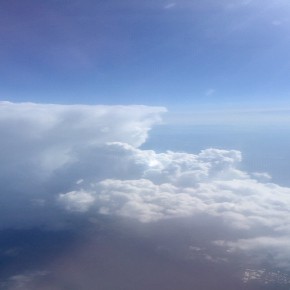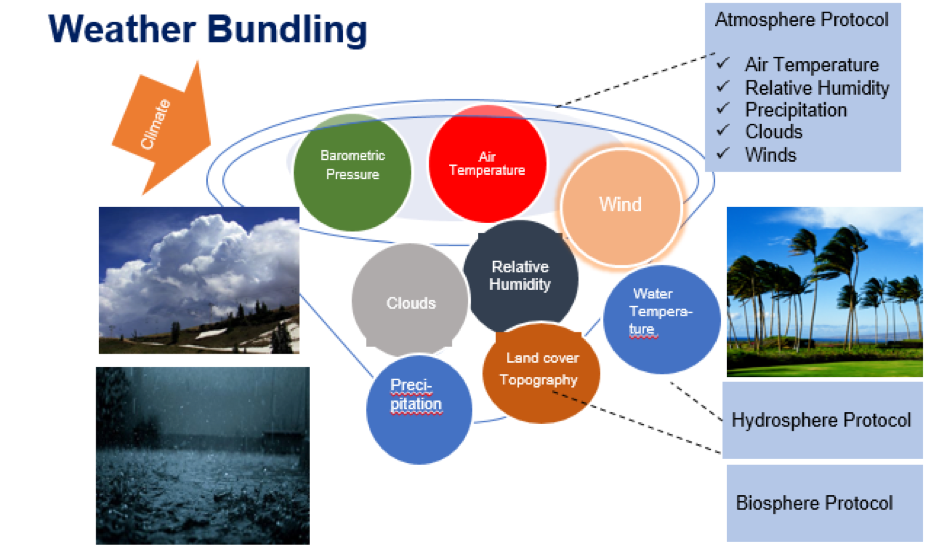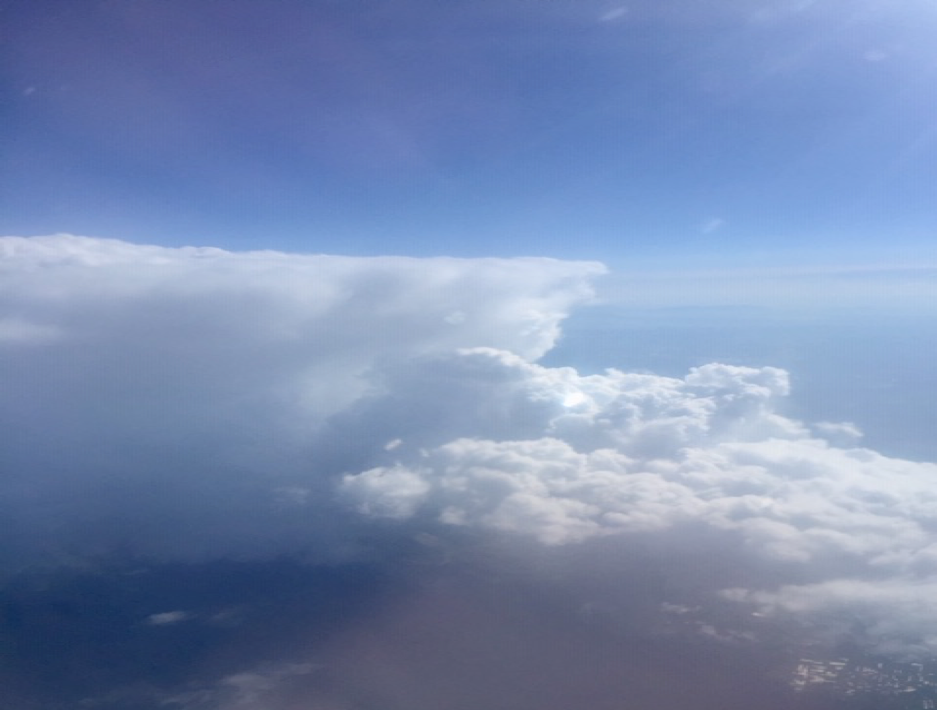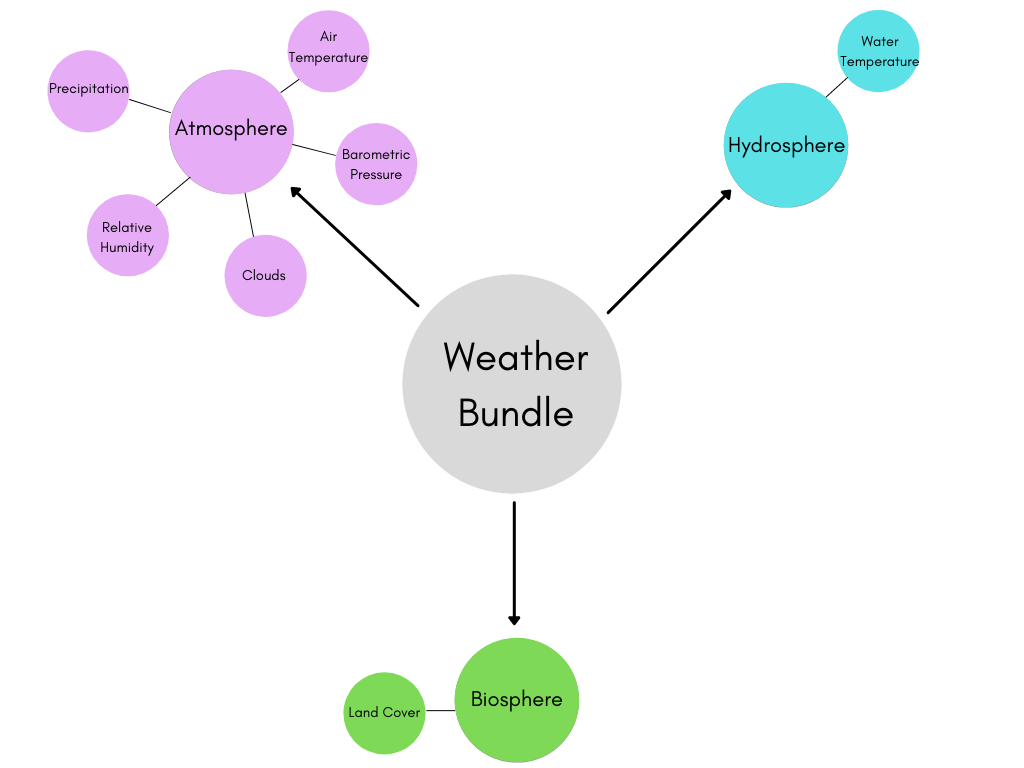Weather Bundle - Earth as a System
Weather Protocol Bundle
Weather, is the state of the atmosphere at a particular place during a short period of time. It reflects atmospheric parameters like air temperature, air pressure, air humidity, precipitation, clouds, and the wind. Furthermore, it's directly related to the energy budget of a region. Because of this interrelationship, the weather is influenced by the region's land cover, which can both modulate the amount of solar radiation absorbed or reflected by the ground as well as affect the how much thermal radiation is emitted.
Weather varies around the world and changes over minutes, hours, days, and weeks. The majority of weather events take place in the troposphere, which is the section of Earth’s atmosphere that extends from ground-level to roughly 8-15 km in the air. Inside the GLOBE Weather Bundle, you can find GLOBE Protocols and datasets that will help you better understand how the weather interacts with the various Earth Spheres.
Learn more about MyNASA Data and the Weather protocol bundle.

Bundle Overview
- Atmosphere
- Air Temperature
-
Air temperature depends on the energy budget of a particular area. It also affects air pressure, relative humidity, the rate of evaporation, wind speed and direction, and precipitation patterns and type. Many interesting short-term temperature fluctuations occur in connection with local weather disturbances. For example, a cold front can reduce air temperature close to the ground by several degrees Celsius. Similarly, air temperature will increase with the passage of a warm front.
-
- Barometric Pressure
- In areas with unstable and ascending air masses, low pressure systems tend to develop at the surface and high pressure ones at the top of the troposphere. This can have significant impacts for local weather. For example, there's a close correlation between the energy budget, air temperature, air pressure, and the wind. When this energy budget changes, it affects the local air temperature which leads to a change of air pressure. The air pressure disturbance then activates a pressure gradient force—the pressure difference between multiple areas—which forces the movement of an air mass from a high-pressure area to a low-pressure one. This is the origin of winds, the intensity of which depend on how much the energy budget is disturbed, and thus the air temperature/pressure. The larger the pressure gradient, the stronger the winds.
- Clouds
- Clouds are formed when water vapor is condensed on aerosol particles that are suspended in the air. Because inverse relationship between pressure and altitude, this condensation occurs when air masses are cooled by expansion during their ascent up through the atmosphere. Clouds of vertical extent, i.e. Cumulus and Cumulonimbus, reflect an instability in the lower atmosphere and indicate convective processes. These types of clouds are usually associated with low pressure systems and bad weather.
- Precipitation
- Precipitation is one of the three main processes that constitute the hydrological cycle and is a major component when we think about the weather. Water evaporates from ocean, land, and freshwater surfaces, condenses to form clouds and then returns to Earth’s surface as precipitation.
- Relative Humidity
- Atmospheric humidity is an important weather parameter for local and global precipitation. All types of precipitation, including drizzle, rain, and snow are produced as a result of the condensation of atmospheric moisture.
- Air Temperature
- Hydrosphere
- Water Temperature
- The water's temperature affects the evaporation rate of a water body. Higher rates of evaporation lead to higher humidity levels, which have broad-reaching effects on air pressure, air temperature, cloud formation, and precipitation. These interdependencies all work together to influence the weather in a particular region.
- Water Temperature
- Biosphere
- Land Cover
- Knowing the type of materials at the surface is useful for defining the energy budget of a particular area. Land cover impacts this budget by affecting the albedo, thermal emission coefficient, and heat capacity of the surface. For example, impervious urban materials, like asphalt and concrete, don't retain water for evaporation, while vegetation allows water to transpire the moisture in the soil and on the leaves, thus increasing atmospheric humidity.
- Knowing the type of materials at the surface is useful for defining the energy budget of a particular area. Land cover impacts this budget by affecting the albedo, thermal emission coefficient, and heat capacity of the surface. For example, impervious urban materials, like asphalt and concrete, don't retain water for evaporation, while vegetation allows water to transpire the moisture in the soil and on the leaves, thus increasing atmospheric humidity.
- Land Cover

Weather includes and at the same time is affected by a vast variety of parameters such as sunshine, temperature, atmospheric pressure, humidity, precipitation, clouds and cloudiness, wind direction, and speed; it also refers to thunderstorms, blizzards, floods, heatwaves, etc.
Weather events that take place in an area are controlled by changes in air pressure. Typically high pressure areas are associated with clear skies, while low-pressure areas are covered with clouds.
Weather can have an impact on well-being as extreme weather events can destroy properties and even result in human casualties.
Because climate change is causing extreme weather events to become more frequent, more intense, and of increased duration, understanding our weather at global, regional, and local scales, is highly important.
Predicting the Weather
To most effectively predict the weather, it's important to understand the difference between weather and climate, even though both depend on many of the same atmospheric parameters.
Weather is typically considered on shorter timespans or particular events, while the climate is a more long-term characterization of a region's various ecological phenomenon. Once we understand how the two concepts differ, we can begin to draw conclusions and predictions about future weather patterns in a particular area.
In order to achieve the most accurate weather forecasts, we must employ a variety of methods and studies, including:
- Monitoring atmospheric parameters to predict or explain changes in prevailing weather conditions
- Understanding the interdependencies of the various atmospheric parameters
- Linking the atmospheric parameters to the energy and water budget of our area of interest
- Understanding the dynamics of the atmosphere in terms of cold/warm fronts, high/low-pressure systems, cloud formation, etc.
To get an idea of how all these different environmental variables are incorporated into the Weather Bundle, check out the following case studies:
Case Study 1: Define the relationship between air temperature and air pressure (at the ground)
Populate the Table below, for a selected day for an area of interest. Once the Table is completed, work out a graphical representation of the relationship between air temperature and air pressure for the area measured. Observe the correlation between these atmospheric parameters and explain their changes.
|
Time of day |
Air temperature (deg Celsius) |
Air pressure (mb) |
|
09.00 |
|
|
|
12.00 |
|
|
|
15.00 |
|
|
|
18.00 |
|
|
|
21.00 |
|
|
|
24.00 |
|
|
Case Study 2. Link the presence of clouds to atmospheric pressure
Populate the Table below, for selected days. Take note that air descends in high pressure systems, a fact which results in cloud evaporation. High pressure is almost always considered a sign of good or fair weather. On the contrary in low pressure systems, air ascends and develops clouds (and eventually storms). Thus low pressure is associated with bad weather.
|
Day |
Air pressure (mb) |
Presence of clouds (yes/no) |
|
|
|
|
|
|
|
|
|
|
|
|
|
|
|
|
|
|
|
|
Case Study 3. Follow the formation of Cumulonimbus
Cumulonimbus (Cb) clouds grow vertically and their tops can reach altitudes of 10 km and higher. At this height, the prevailing winds (of high intensity) will flatten the top of the cloud, shaping it as an anvil. They reflect strong instability in the troposphere and high amounts of water vapor, for instance due to excessive evaporation. Cumulonimbus clouds are associated with low pressure systems forcing air masses to rapidly ascend and form convective clouds due to condensation; they bring heavy rain, snow, hail, lightning, and sometimes tornadoes.
A Cumulonimbus cloud is recognized as follows: (a) the cloud has grown very high in the atmosphere and is distinct from other clouds in the same area; (b) the cloud is dark in its base, a clear sign of potential rain; (c) the cloud has a flat top; (d) sudden and intense rain takes place; and (e) lighting and thunder are observed.
Figure 2 shows a Cumulonimbus cloud as observed from an airplane flying at an altitude of 30,000 ft.

Figure 2. A Cumulonimbus cloud in full deployment. Note the anvil shape top, a characteristic sign of high winds (photo courtesy: C. Cartalis).
Regardless if it's hot or cold, dry or humid, windy or calm, weather is a fascinating ensemble of many atmospheric parameters described through the laws of physics and thermodynamics. The interdependence of these parameters both define the prevailing weather patterns as well as control their evolution in space and time.
Weather is influenced by climate change in particular. Since increases in air or sea surface temperature may lead to extreme weather events of increased frequency and intensity, it's crucial that we develop a better understanding how weather affects, and is affected by, our global environment. For example, the weakening of the polar cell in the Arctic is associated with the thermal disturbance in the area, potentially associated to the melting of ice. Once the polar cell is weakened, very cold air masses can move toward the equator in a phenomenon known as cold air intrusion. These masses can cause further weather disturbances in the lower latitudes.
Since weather influences human security as well as a wide number of human activities and economic sectors, it's of great importance to establish and operate spatially-wide monitoring networks to increase our forecasting ability. By taking advantage of meteorological satellite data, we can start to predict the weather with improved accuracy as well as maintain meteorological records to support weather modeling and analysis.
Acknowledgments
Compiled by:
- Prof C. Cartalis
- Dr. Dixon Butler
Many thanks to the members of the Science Working Group for their comments.
References
- GLOBE: https://www.globe.gov/
- NCAS: https://ncas.ac.uk/learn/what-is-weather/
- NASA: https://climatekids.nasa.gov/menu/weather-and-climate/
- UCAR-Center for Science Education: https://scied.ucar.edu/learning-zone/how-weather-works/weather






